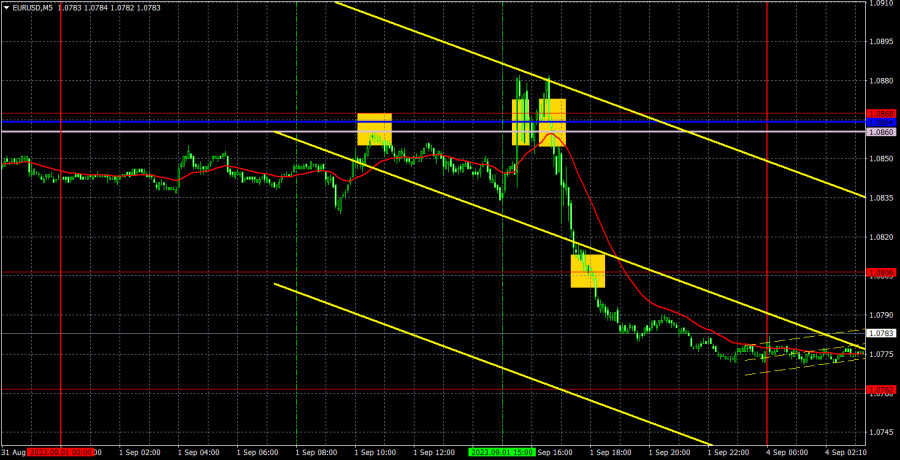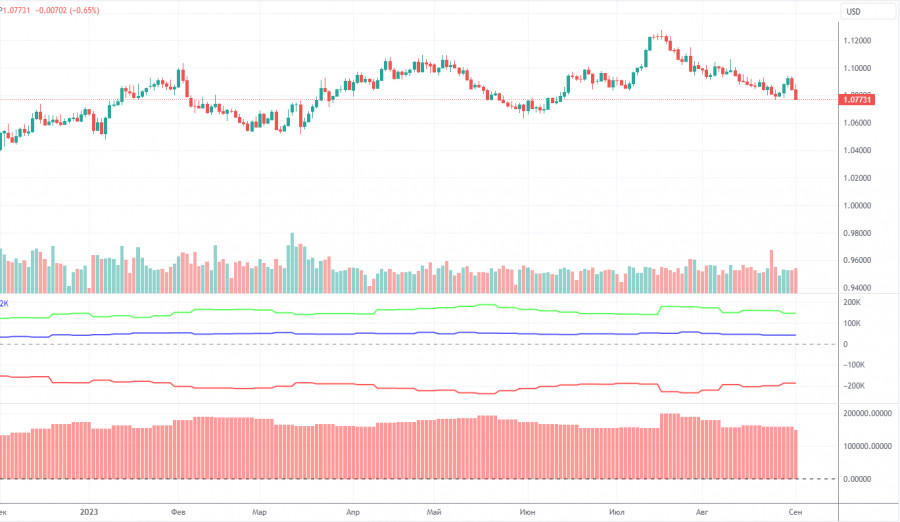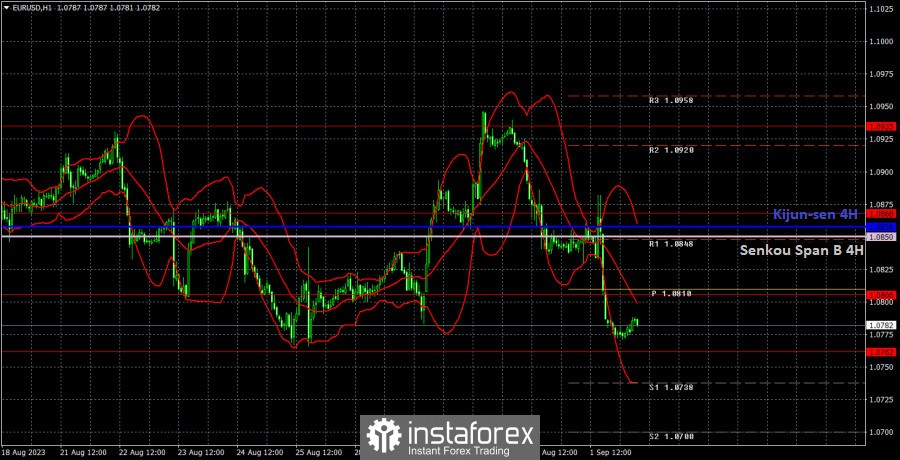

EUR/USD broke down significantly for the second consecutive day. If the euro had a reason to do so on Thursday (though they were quite doubtful), then it simply had none on Friday. Let's briefly go over the most important events. The NonFarm Payrolls report turned out to be weak. Nonfarm payrolls increased by 187,000 jobs last month (below the "neutral" value of 200,000), which was slightly above expectations. However, the July figure was revised downward by 30,000. So, overall, we consider it a weak report. The unemployment rate increased to 3.8%, which was unexpected. The ISM Manufacturing Index increased and even exceeded expectations, but it remained below the 50.0 mark. Therefore, there were good reasons to buy the dollar, which the market did on Friday.
In any macroeconomic background, we only expect the pair to fall, as we have repeatedly mentioned in recent weeks. So, in this regard, everything is logical. Friday's trading signals were ambiguous and challenging. While there were no issues with the bounce off the Senkou Span B line during the European session, the next two rebounds occurred during the release of US reports, and the pair was thrown back and forth. Moreover, the reports implied that the pair would rise, not fall. Therefore, the best solution would have been to ignore these signals since the situation was unclear and ambiguous. The last sell signal near the 1.0806 level was formed too late to execute, but traders could still earn a few dozen pips.
COT report:
On Friday, a new COT report for August 29 was released. Over the last 11 months, COT reports fully corresponded to what is happening in the market. The chart above clearly shows that the net position of major traders (the second indicator) began to grow in September 2022 and at about the same time the euro started rising too. In the last 6-7 months, the net position has not risen but the euro remains at very high levels. At the moment, the net position of non-commercial traders is bullish and remains strong. The euro continues to stay relatively expensive compared to the dollar.
I have already mentioned the fact that a fairly high value of the net position signals the end of an uptrend. This is also confirmed by the first indicator where the red and green lines are very far from each other. Usually, it precedes the end of the trend. During the last reporting week, the number of long positions of the non-commercial group of traders decreased by 8,800 and the number of short ones rose by 3,200. The net position decreased by 12,100 contracts. The number of long positions is higher than the number of short ones of non-commercial traders by 148,000. This is a very large gap as the difference is almost threefold. Even without COT reports, it is obvious that the euro should decline but speculators are still in no hurry to sell.
Analysis of EUR/USD 1H
On the 1H chart, the pair finally ended its bullish correction, since it doesn't have a good reason to rise in the medium-term. The dollar could have fallen on Friday (it had every reason to), but instead it grew. Now everything depends on the 1.0762 level, which stopped the price from falling further last time. The pair could still start a new phase of the bullish correction from the current positions.
On September 4, traders should pay attention to the following key levels: 1.0658-1.0669, 1.0762, 1.0806, 1.0868, 1.0935, 1.1043, 1.1092, 1.1137, as well as the Senkou Span B line (1.0850) and the Kijun-sen line (1.0858). The lines of the Ichimoku indicator can move during the day, which should be taken into account when determining trading signals. There are support and resistance levels that can be used to lock in profits. Traders look for signals at rebounds and breakouts. It is recommended to set the Stop Loss orders at the breakeven level when the price moves in the right direction by 15 pips. This will protect against possible losses if the signal turns out to be false.
No significant reports are planned in the US. European Central Bank President Christine Lagarde and Chief Economist Philip Lane are on the calendar to speak today with investors looking for important information. Both officials are expected to deliver more dovish rhetoric, which means the euro is in a risky territory.
Description of the chart:Support and resistance levels are thick red lines near which the trend may end. They do not provide trading signals;
The Kijun-sen and Senkou Span B lines are the lines of the Ichimoku indicator, plotted to the 1H timeframe from the 4H one. They provide trading signals;
Extreme levels are thin red lines from which the price bounced earlier. They provide trading signals;
Yellow lines are trend lines, trend channels, and any other technical patterns;
Indicator 1 on the COT charts is the net position size for each category of traders;
Indicator 2 on the COT charts is the net position size for the Non-commercial group.